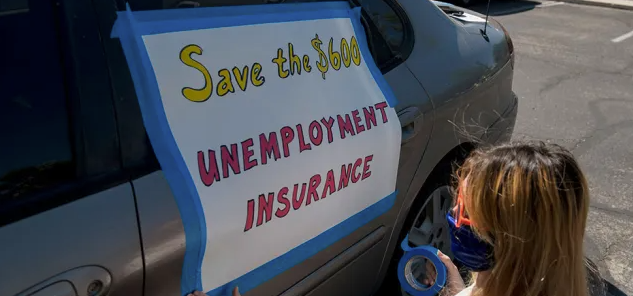By GREGORY N. HEIRES
Unemployed workers and advocacy groups are mobilizing against state plans to carry out early cuts in the federal government’s extra pandemic unemployment benefits.
At least seven states face lawsuits over the cuts. In some instances, the fightback is succeeding.
In July, a judge in Maryland rejected Republican Gov. Larry Hogan’s appeal of a lawsuit that blocked the state’s plan to cut off benefits.
In Indiana, a judge ruled on June 25 that the state must continue to provide the COVID unemployment benefit to 230,000 unemployed workers until a lawsuit challenging the early termination of the compensation is decided.
Another fightback effort includes a Facebook group of 1,800 Tennesseans suing Gov. Bill Lee and the State of Tennessee to stop federal unemployment benefits more than two months before the program expires.
In June, the grassroots groups Unemployed Workers Union of Ohio and Unemployed Action Ohio, with support from the Ohio Organizing Collaborative, held a news conference at the Statehouse to protest Governor Mike DeWine’s benefit cuts. The Ohio Organizing Collaborative is reaching out to unemployed workers online to join its campaign to block the cuts.
Cuts Fail to Spur Hiring
The federal government’s extra $300 benefit is scheduled to expire in September. But 26 states—all but two led by Republican governors–have already begun to eliminate it. More than 4.7 million workers will lose the $300 supplement in the 26 states, according to the National Employment Law Project (NELP).
But the attack on unemployment benefits goes beyond the $300 cut. Twenty-two states are also cutting other federal pandemic benefits as well as state benefits. That will leave 2.3 million workers without any federal and state unemployment assistance at all, according to NELP.
The governors say they are carrying out the cuts to spur hiring. But so far, there is little evidence that the cuts are having that impact. About a month after two dozen GOP-led states began slashing the federal government’s extra benefit, a group of Morgan Stanley economists found the cuts had little effect on the labor market. “It appears that generous unemployment benefits are likely no more of a factor than other impediments, including childcare, transportation, and health concerns, to workplace re-entry,” Morgan Stanley economists wrote.
“Conservative cuts in unemployment benefits make it harder for people to reflect on whether they want to go back to work, even as COVID cases are rising and even while average wages stay low,” said Frank Stricker, author of “American Unemployment: Past, Present, and Future and a board member of the full-employment advocacy group National Jobs for All Network.
“Despite the stories about employers having to raise pay to attract workers, real hourly wages (in purchasing power) have fallen more than 2% over the year. The shortage of workers is not short enough to increase wages faster than prices. Making more people seek work right away means less pressure for employers to raise pay.”
In his podcast, Economic Update, economist Richard D. Wolff charged that the Republican-led states were answering the call of businesses to make workers return to their jobs while providing inadequate compensation.
“Labor Shortage?” Wolff said. “Listen, Jack. You raise the wages, the shortage will vanish.”
NJFAN Chair Trudy Goldberg echoed Wolff’s criticism of the cuts and expressed support for the grassroots groups in Ohio and other states fighting to block them.
In June, President Joe Biden said it “makes sense” for the federal government to stick with its plan for the benefits to expire in September. It’s the Republican-led states that are double-crossing millions of workers.
This article appeared Aug. 6 in the Jobs for All Newsletter.
The New Crossroads blogger Gregory N. Heires is the editor of the Jobs for All Newsletter and a former president of the Metro NY Labor Communications Council.



